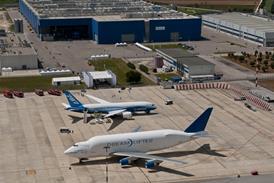Aurora Flight Sciences will attempt to break the "infinite endurance" barrier for aircraft in three years with a 150m (492ft)wingspan, solar-powered aircraft called Odysseus.
It is the first publicly-unveiled answer to the unrefuelled endurance challenge set by the Vulture programme, sponsored by the US Defense Advanced Research Projects Agency.
The Northrop Grumman RQ-4 Global Hawk has made a 40h unrefuelled flight routine, while Aerovironment's Global Observer has shown week-long endurance.
The Vulture programme aims to demonstrate a prototype aircraft that can remain on-station for more than 44,000h, or five years, while generating 5kW to power a 450kg (1,000lb) payload.
Aurora's Odysseus is the first aircraft selected by DARPA for a Phase 1 concept design stage. More designs will be announced by the end of April. Next year, DARPA will launch Phase II to demonstrate a one-fifth-scale prototype.
Vulture's endurance goal requires spacecraft-like reliability for systems and payloads, but sets an altogether new standard for airframe design and aerodynamic control at "near-space" altitudes ranging from 65,000ft to 90,000ft.
Aurora's chief engineer Bob Parks, speaking exclusively to Flightglobal.com before the public unveiling of Odysseus on 23 April, explained the Aurora team's modular approach.
Odysseus comprises three sections that independently take off and dock at high-altitude. Each 50m-wide, 1,350kg section can be replaced after a one to two-year service life by simply undocking. A new module arrives to join the other sections.
Parks says the modular approach produces two key benefits. First, the floppiness of a 150m-wide panel is reduced on take-off. Wing-loading amounts to 1lb/ft2 (5kg/m2). Second, Parks adds, induced drag is the same for the section and the composite aircraft, so the design offers triple the weight for the same drag penalty as a 50m-wide section.
The docking technique, however, introduces the complexity of joining the sections on-station. Aurora is relying on Sierra Nevada, one of three major partners on Odysseus, to develop a docking system based on autonomous refuelling technology.
Aerodynamic control is solved by innovative cruciform tails that rotate on the axes of attached booms, allowing highly-efficient solar cells on the tail's horizontal wing to chase the angle of the sun.
The need to align the aircraft's photovoltaic collectors to the angle of the sun, even at high latitudes, drives another unique design feature of Odysseus.
Each section panel is joined with a hinge that can be folded, which allows Odysseus to transform from a flat panel to a "Z-wing". This change of shape allows the main sections to aim directly at the sun even in the most extreme condition for a solar-powered aircraft: on-station at high latitudes during the month of the winter solstice.
"The highest limit is the arctic at winter solstice," Parks says. "The closer you try to get to that, the harder the problem is." At night, Odysseus could shift into the more efficient flat-wing shape to preserve energy until sunrise.
DARPA conceived Vulture as a military application to prove that an aircraft can perform the same surveillance and communications relay roles of a geostationary satellite. Aurora also hopes to capture the market for broadband telecommunications and scientific Earth-observing missions.
Aurora president John Langford acknowledges interest to join with a larger partner, if its concept advances. "I think Aurora is uniquely qualified to do this," he says. "We have a team that covers the bases that DARPA wanted covered." However, he adds: "We are actively open to and looking for any kind of teaming and partnering."
Source: FlightGlobal.com




















